Literature Review: Viusasa's Growth Strategies in Kenyan Market
VerifiedAdded on 2023/04/22
|8
|1569
|376
Literature Review
AI Summary
This literature review examines the challenges and opportunities for the growth of local Video on Demand (VOD) platforms in Africa, specifically focusing on Viusasa in Kenya. The review analyzes existing literature to understand the impact of digital advancements on customer behavior, including online usage and the concept of infotainment. It explores key issues such as content generation costs, revenue models, smartphone access, data costs, and the importance of local language content. The analysis considers the external business environment, including political, economic, social, technological, legal, and environmental factors using the PESTLE model. The review also discusses potential new competitors and barriers to market entry. The review incorporates research on consumer behavior, technology adoption, and the influence of social factors. The findings highlight the need for Viusasa to create awareness, enhance infotainment practices, and address the challenges of technology usage in Kenya to grow its customer base and succeed in the competitive VOD market. The review is based on academic articles and research papers to provide insights into the strategies that Viusasa can adopt to increase its usage and market presence.
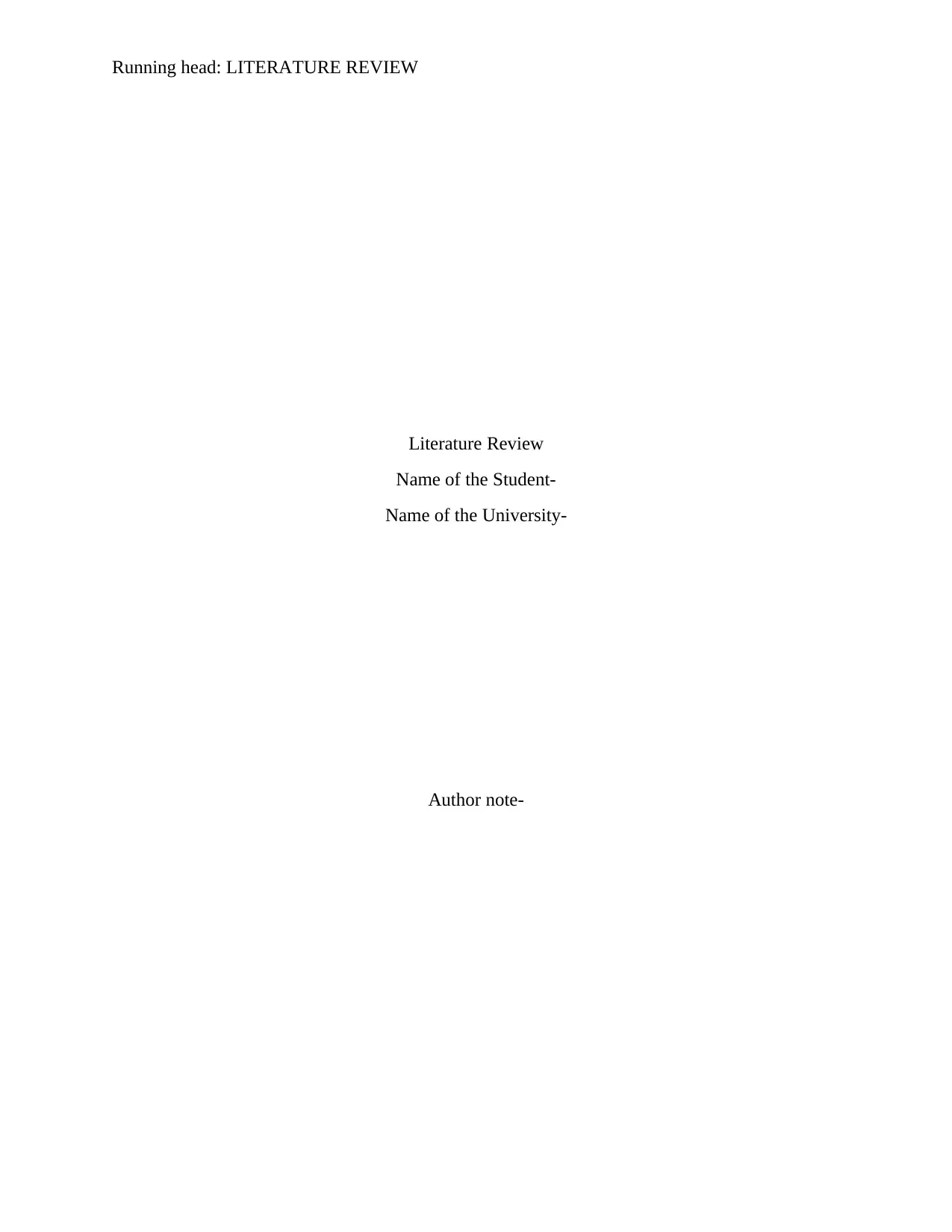
Running head: LITERATURE REVIEW
Literature Review
Name of the Student-
Name of the University-
Author note-
Literature Review
Name of the Student-
Name of the University-
Author note-
Paraphrase This Document
Need a fresh take? Get an instant paraphrase of this document with our AI Paraphraser
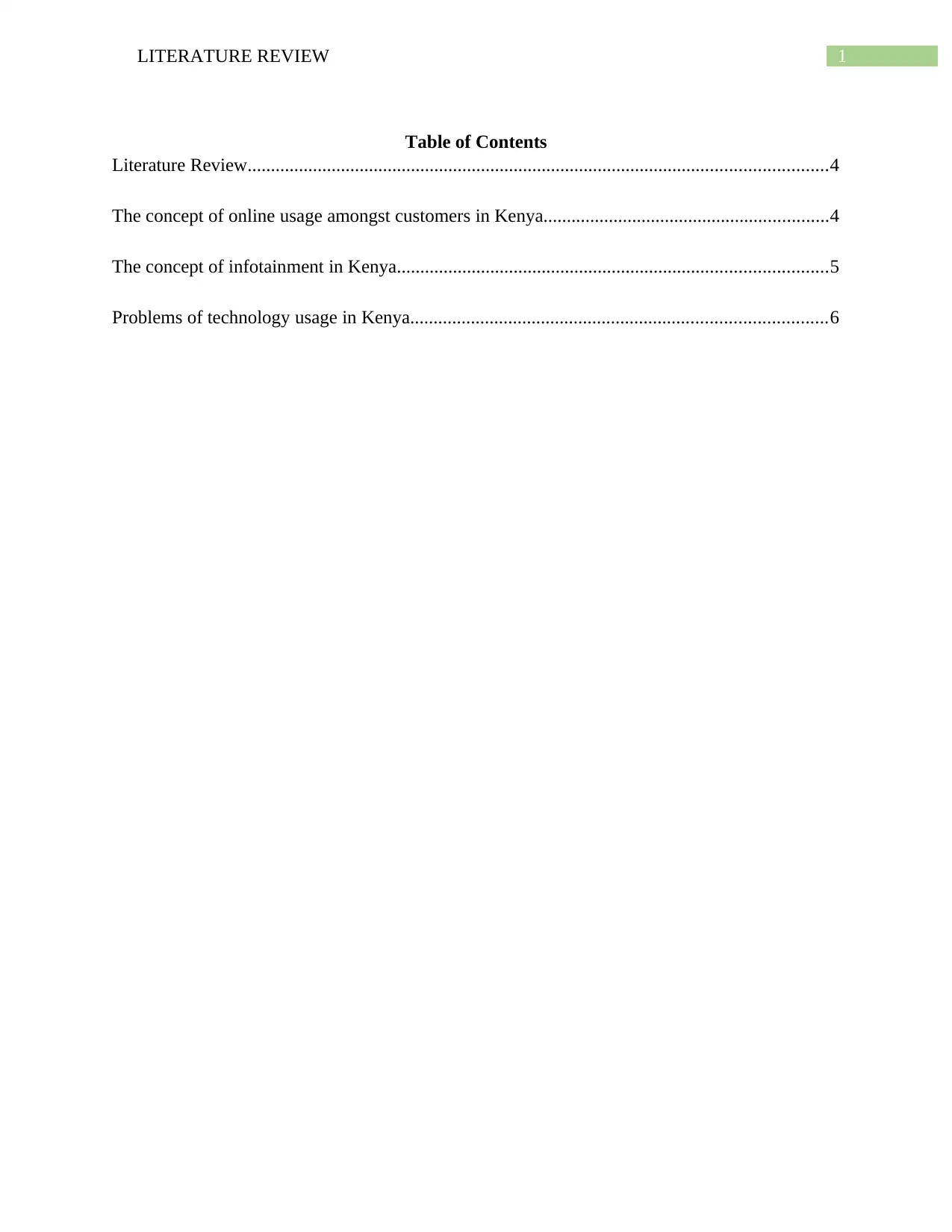
1LITERATURE REVIEW
Table of Contents
Literature Review............................................................................................................................4
The concept of online usage amongst customers in Kenya.............................................................4
The concept of infotainment in Kenya............................................................................................5
Problems of technology usage in Kenya.........................................................................................6
Table of Contents
Literature Review............................................................................................................................4
The concept of online usage amongst customers in Kenya.............................................................4
The concept of infotainment in Kenya............................................................................................5
Problems of technology usage in Kenya.........................................................................................6
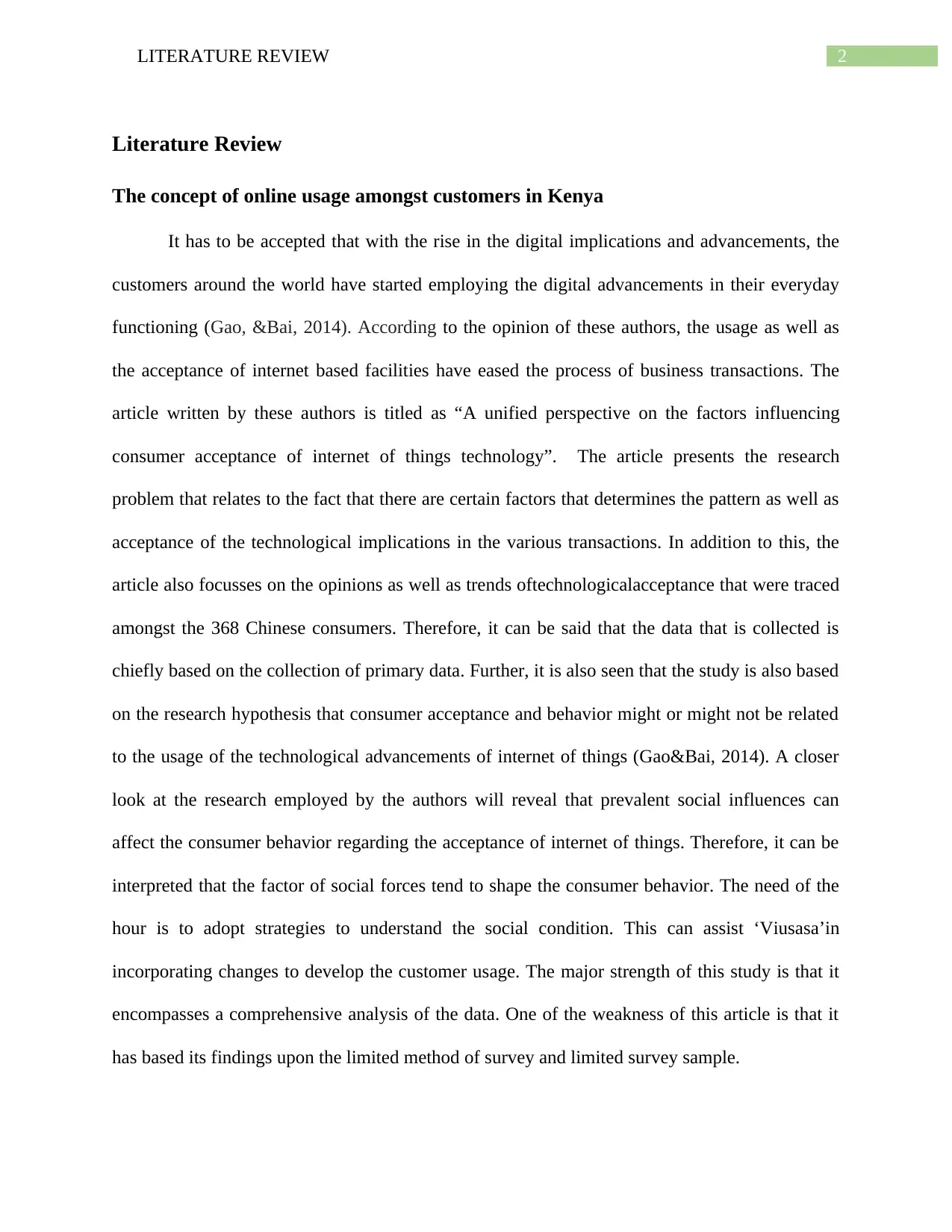
2LITERATURE REVIEW
Literature Review
The concept of online usage amongst customers in Kenya
It has to be accepted that with the rise in the digital implications and advancements, the
customers around the world have started employing the digital advancements in their everyday
functioning (Gao, &Bai, 2014). According to the opinion of these authors, the usage as well as
the acceptance of internet based facilities have eased the process of business transactions. The
article written by these authors is titled as “A unified perspective on the factors influencing
consumer acceptance of internet of things technology”. The article presents the research
problem that relates to the fact that there are certain factors that determines the pattern as well as
acceptance of the technological implications in the various transactions. In addition to this, the
article also focusses on the opinions as well as trends oftechnologicalacceptance that were traced
amongst the 368 Chinese consumers. Therefore, it can be said that the data that is collected is
chiefly based on the collection of primary data. Further, it is also seen that the study is also based
on the research hypothesis that consumer acceptance and behavior might or might not be related
to the usage of the technological advancements of internet of things (Gao&Bai, 2014). A closer
look at the research employed by the authors will reveal that prevalent social influences can
affect the consumer behavior regarding the acceptance of internet of things. Therefore, it can be
interpreted that the factor of social forces tend to shape the consumer behavior. The need of the
hour is to adopt strategies to understand the social condition. This can assist ‘Viusasa’in
incorporating changes to develop the customer usage. The major strength of this study is that it
encompasses a comprehensive analysis of the data. One of the weakness of this article is that it
has based its findings upon the limited method of survey and limited survey sample.
Literature Review
The concept of online usage amongst customers in Kenya
It has to be accepted that with the rise in the digital implications and advancements, the
customers around the world have started employing the digital advancements in their everyday
functioning (Gao, &Bai, 2014). According to the opinion of these authors, the usage as well as
the acceptance of internet based facilities have eased the process of business transactions. The
article written by these authors is titled as “A unified perspective on the factors influencing
consumer acceptance of internet of things technology”. The article presents the research
problem that relates to the fact that there are certain factors that determines the pattern as well as
acceptance of the technological implications in the various transactions. In addition to this, the
article also focusses on the opinions as well as trends oftechnologicalacceptance that were traced
amongst the 368 Chinese consumers. Therefore, it can be said that the data that is collected is
chiefly based on the collection of primary data. Further, it is also seen that the study is also based
on the research hypothesis that consumer acceptance and behavior might or might not be related
to the usage of the technological advancements of internet of things (Gao&Bai, 2014). A closer
look at the research employed by the authors will reveal that prevalent social influences can
affect the consumer behavior regarding the acceptance of internet of things. Therefore, it can be
interpreted that the factor of social forces tend to shape the consumer behavior. The need of the
hour is to adopt strategies to understand the social condition. This can assist ‘Viusasa’in
incorporating changes to develop the customer usage. The major strength of this study is that it
encompasses a comprehensive analysis of the data. One of the weakness of this article is that it
has based its findings upon the limited method of survey and limited survey sample.
⊘ This is a preview!⊘
Do you want full access?
Subscribe today to unlock all pages.

Trusted by 1+ million students worldwide
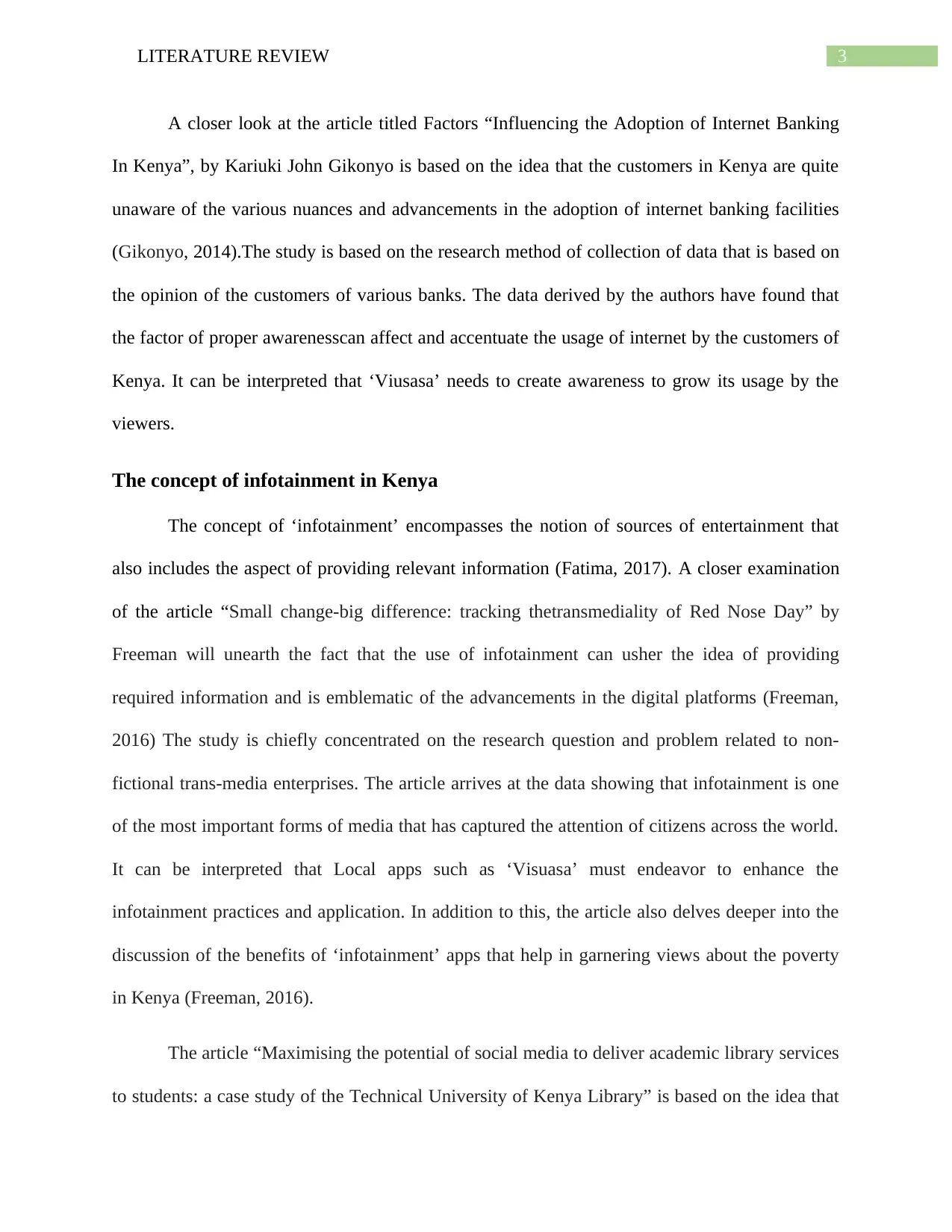
3LITERATURE REVIEW
A closer look at the article titled Factors “Influencing the Adoption of Internet Banking
In Kenya”, by Kariuki John Gikonyo is based on the idea that the customers in Kenya are quite
unaware of the various nuances and advancements in the adoption of internet banking facilities
(Gikonyo, 2014).The study is based on the research method of collection of data that is based on
the opinion of the customers of various banks. The data derived by the authors have found that
the factor of proper awarenesscan affect and accentuate the usage of internet by the customers of
Kenya. It can be interpreted that ‘Viusasa’ needs to create awareness to grow its usage by the
viewers.
The concept of infotainment in Kenya
The concept of ‘infotainment’ encompasses the notion of sources of entertainment that
also includes the aspect of providing relevant information (Fatima, 2017). A closer examination
of the article “Small change-big difference: tracking thetransmediality of Red Nose Day” by
Freeman will unearth the fact that the use of infotainment can usher the idea of providing
required information and is emblematic of the advancements in the digital platforms (Freeman,
2016) The study is chiefly concentrated on the research question and problem related to non-
fictional trans-media enterprises. The article arrives at the data showing that infotainment is one
of the most important forms of media that has captured the attention of citizens across the world.
It can be interpreted that Local apps such as ‘Visuasa’ must endeavor to enhance the
infotainment practices and application. In addition to this, the article also delves deeper into the
discussion of the benefits of ‘infotainment’ apps that help in garnering views about the poverty
in Kenya (Freeman, 2016).
The article “Maximising the potential of social media to deliver academic library services
to students: a case study of the Technical University of Kenya Library” is based on the idea that
A closer look at the article titled Factors “Influencing the Adoption of Internet Banking
In Kenya”, by Kariuki John Gikonyo is based on the idea that the customers in Kenya are quite
unaware of the various nuances and advancements in the adoption of internet banking facilities
(Gikonyo, 2014).The study is based on the research method of collection of data that is based on
the opinion of the customers of various banks. The data derived by the authors have found that
the factor of proper awarenesscan affect and accentuate the usage of internet by the customers of
Kenya. It can be interpreted that ‘Viusasa’ needs to create awareness to grow its usage by the
viewers.
The concept of infotainment in Kenya
The concept of ‘infotainment’ encompasses the notion of sources of entertainment that
also includes the aspect of providing relevant information (Fatima, 2017). A closer examination
of the article “Small change-big difference: tracking thetransmediality of Red Nose Day” by
Freeman will unearth the fact that the use of infotainment can usher the idea of providing
required information and is emblematic of the advancements in the digital platforms (Freeman,
2016) The study is chiefly concentrated on the research question and problem related to non-
fictional trans-media enterprises. The article arrives at the data showing that infotainment is one
of the most important forms of media that has captured the attention of citizens across the world.
It can be interpreted that Local apps such as ‘Visuasa’ must endeavor to enhance the
infotainment practices and application. In addition to this, the article also delves deeper into the
discussion of the benefits of ‘infotainment’ apps that help in garnering views about the poverty
in Kenya (Freeman, 2016).
The article “Maximising the potential of social media to deliver academic library services
to students: a case study of the Technical University of Kenya Library” is based on the idea that
Paraphrase This Document
Need a fresh take? Get an instant paraphrase of this document with our AI Paraphraser
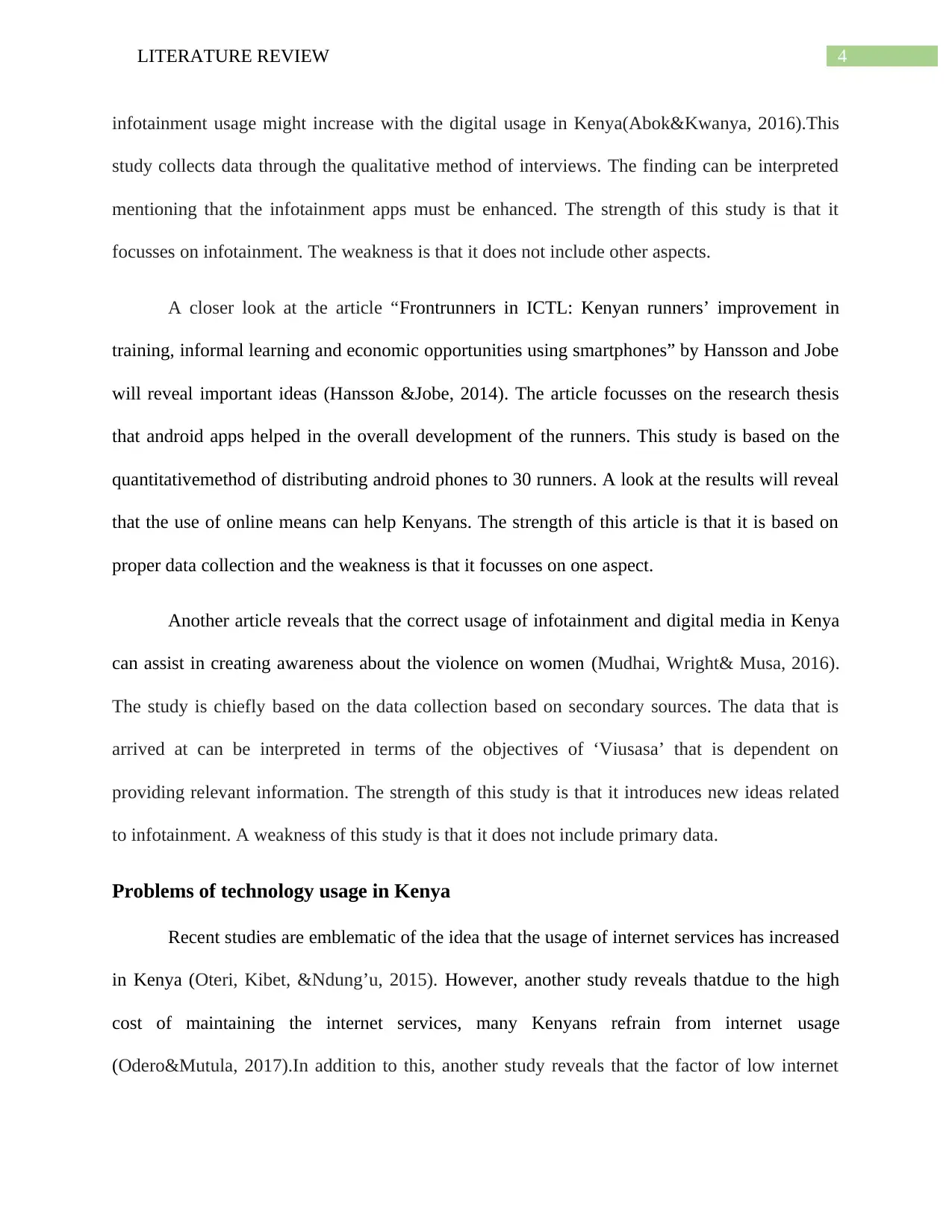
4LITERATURE REVIEW
infotainment usage might increase with the digital usage in Kenya(Abok&Kwanya, 2016).This
study collects data through the qualitative method of interviews. The finding can be interpreted
mentioning that the infotainment apps must be enhanced. The strength of this study is that it
focusses on infotainment. The weakness is that it does not include other aspects.
A closer look at the article “Frontrunners in ICTL: Kenyan runners’ improvement in
training, informal learning and economic opportunities using smartphones” by Hansson and Jobe
will reveal important ideas (Hansson &Jobe, 2014). The article focusses on the research thesis
that android apps helped in the overall development of the runners. This study is based on the
quantitativemethod of distributing android phones to 30 runners. A look at the results will reveal
that the use of online means can help Kenyans. The strength of this article is that it is based on
proper data collection and the weakness is that it focusses on one aspect.
Another article reveals that the correct usage of infotainment and digital media in Kenya
can assist in creating awareness about the violence on women (Mudhai, Wright& Musa, 2016).
The study is chiefly based on the data collection based on secondary sources. The data that is
arrived at can be interpreted in terms of the objectives of ‘Viusasa’ that is dependent on
providing relevant information. The strength of this study is that it introduces new ideas related
to infotainment. A weakness of this study is that it does not include primary data.
Problems of technology usage in Kenya
Recent studies are emblematic of the idea that the usage of internet services has increased
in Kenya (Oteri, Kibet, &Ndung’u, 2015). However, another study reveals thatdue to the high
cost of maintaining the internet services, many Kenyans refrain from internet usage
(Odero&Mutula, 2017).In addition to this, another study reveals that the factor of low internet
infotainment usage might increase with the digital usage in Kenya(Abok&Kwanya, 2016).This
study collects data through the qualitative method of interviews. The finding can be interpreted
mentioning that the infotainment apps must be enhanced. The strength of this study is that it
focusses on infotainment. The weakness is that it does not include other aspects.
A closer look at the article “Frontrunners in ICTL: Kenyan runners’ improvement in
training, informal learning and economic opportunities using smartphones” by Hansson and Jobe
will reveal important ideas (Hansson &Jobe, 2014). The article focusses on the research thesis
that android apps helped in the overall development of the runners. This study is based on the
quantitativemethod of distributing android phones to 30 runners. A look at the results will reveal
that the use of online means can help Kenyans. The strength of this article is that it is based on
proper data collection and the weakness is that it focusses on one aspect.
Another article reveals that the correct usage of infotainment and digital media in Kenya
can assist in creating awareness about the violence on women (Mudhai, Wright& Musa, 2016).
The study is chiefly based on the data collection based on secondary sources. The data that is
arrived at can be interpreted in terms of the objectives of ‘Viusasa’ that is dependent on
providing relevant information. The strength of this study is that it introduces new ideas related
to infotainment. A weakness of this study is that it does not include primary data.
Problems of technology usage in Kenya
Recent studies are emblematic of the idea that the usage of internet services has increased
in Kenya (Oteri, Kibet, &Ndung’u, 2015). However, another study reveals thatdue to the high
cost of maintaining the internet services, many Kenyans refrain from internet usage
(Odero&Mutula, 2017).In addition to this, another study reveals that the factor of low internet

5LITERATURE REVIEW
speed in innumerable areas of sub-Saharan Africa and regions of Kenya become a major for the
less usage of infotainment apps (Mtebe, 2015).
However, the previous studies fail to encompass the idea of strategies for the growth in
customer’s usage of infotainment apps.
speed in innumerable areas of sub-Saharan Africa and regions of Kenya become a major for the
less usage of infotainment apps (Mtebe, 2015).
However, the previous studies fail to encompass the idea of strategies for the growth in
customer’s usage of infotainment apps.
⊘ This is a preview!⊘
Do you want full access?
Subscribe today to unlock all pages.

Trusted by 1+ million students worldwide
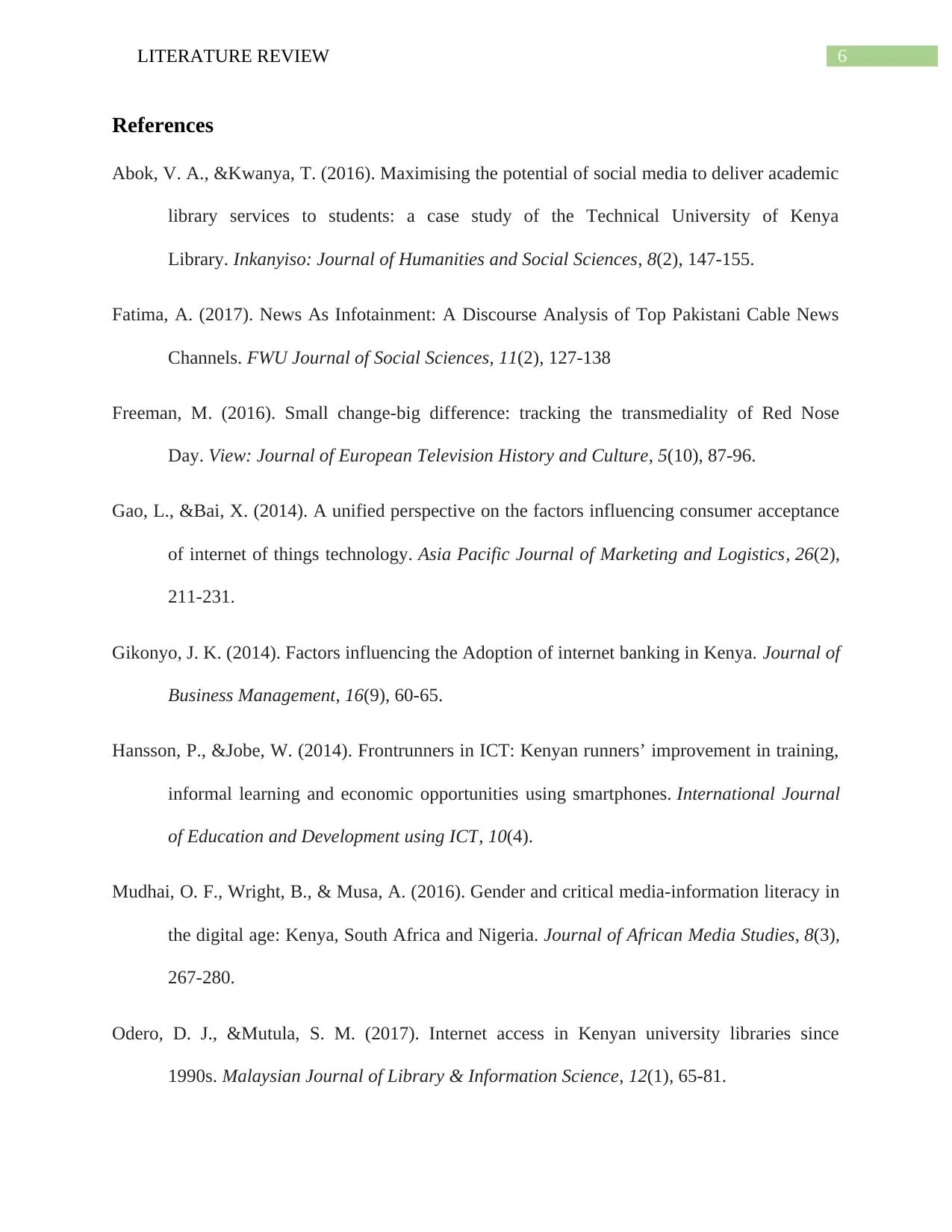
6LITERATURE REVIEW
References
Abok, V. A., &Kwanya, T. (2016). Maximising the potential of social media to deliver academic
library services to students: a case study of the Technical University of Kenya
Library. Inkanyiso: Journal of Humanities and Social Sciences, 8(2), 147-155.
Fatima, A. (2017). News As Infotainment: A Discourse Analysis of Top Pakistani Cable News
Channels. FWU Journal of Social Sciences, 11(2), 127-138
Freeman, M. (2016). Small change-big difference: tracking the transmediality of Red Nose
Day. View: Journal of European Television History and Culture, 5(10), 87-96.
Gao, L., &Bai, X. (2014). A unified perspective on the factors influencing consumer acceptance
of internet of things technology. Asia Pacific Journal of Marketing and Logistics, 26(2),
211-231.
Gikonyo, J. K. (2014). Factors influencing the Adoption of internet banking in Kenya. Journal of
Business Management, 16(9), 60-65.
Hansson, P., &Jobe, W. (2014). Frontrunners in ICT: Kenyan runners’ improvement in training,
informal learning and economic opportunities using smartphones. International Journal
of Education and Development using ICT, 10(4).
Mudhai, O. F., Wright, B., & Musa, A. (2016). Gender and critical media-information literacy in
the digital age: Kenya, South Africa and Nigeria. Journal of African Media Studies, 8(3),
267-280.
Odero, D. J., &Mutula, S. M. (2017). Internet access in Kenyan university libraries since
1990s. Malaysian Journal of Library & Information Science, 12(1), 65-81.
References
Abok, V. A., &Kwanya, T. (2016). Maximising the potential of social media to deliver academic
library services to students: a case study of the Technical University of Kenya
Library. Inkanyiso: Journal of Humanities and Social Sciences, 8(2), 147-155.
Fatima, A. (2017). News As Infotainment: A Discourse Analysis of Top Pakistani Cable News
Channels. FWU Journal of Social Sciences, 11(2), 127-138
Freeman, M. (2016). Small change-big difference: tracking the transmediality of Red Nose
Day. View: Journal of European Television History and Culture, 5(10), 87-96.
Gao, L., &Bai, X. (2014). A unified perspective on the factors influencing consumer acceptance
of internet of things technology. Asia Pacific Journal of Marketing and Logistics, 26(2),
211-231.
Gikonyo, J. K. (2014). Factors influencing the Adoption of internet banking in Kenya. Journal of
Business Management, 16(9), 60-65.
Hansson, P., &Jobe, W. (2014). Frontrunners in ICT: Kenyan runners’ improvement in training,
informal learning and economic opportunities using smartphones. International Journal
of Education and Development using ICT, 10(4).
Mudhai, O. F., Wright, B., & Musa, A. (2016). Gender and critical media-information literacy in
the digital age: Kenya, South Africa and Nigeria. Journal of African Media Studies, 8(3),
267-280.
Odero, D. J., &Mutula, S. M. (2017). Internet access in Kenyan university libraries since
1990s. Malaysian Journal of Library & Information Science, 12(1), 65-81.
Paraphrase This Document
Need a fresh take? Get an instant paraphrase of this document with our AI Paraphraser
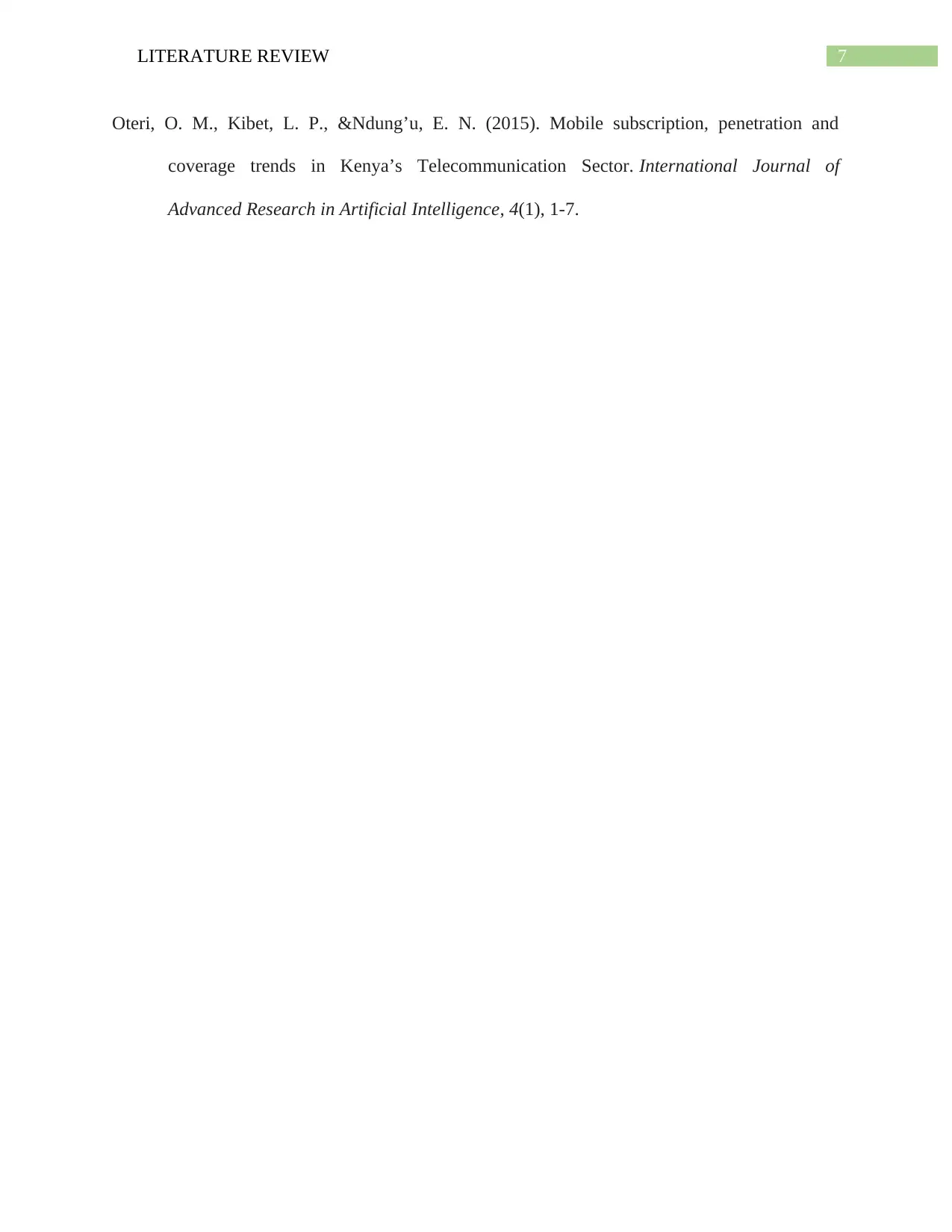
7LITERATURE REVIEW
Oteri, O. M., Kibet, L. P., &Ndung’u, E. N. (2015). Mobile subscription, penetration and
coverage trends in Kenya’s Telecommunication Sector. International Journal of
Advanced Research in Artificial Intelligence, 4(1), 1-7.
Oteri, O. M., Kibet, L. P., &Ndung’u, E. N. (2015). Mobile subscription, penetration and
coverage trends in Kenya’s Telecommunication Sector. International Journal of
Advanced Research in Artificial Intelligence, 4(1), 1-7.
1 out of 8
Related Documents
Your All-in-One AI-Powered Toolkit for Academic Success.
+13062052269
info@desklib.com
Available 24*7 on WhatsApp / Email
![[object Object]](/_next/static/media/star-bottom.7253800d.svg)
Unlock your academic potential
Copyright © 2020–2025 A2Z Services. All Rights Reserved. Developed and managed by ZUCOL.





